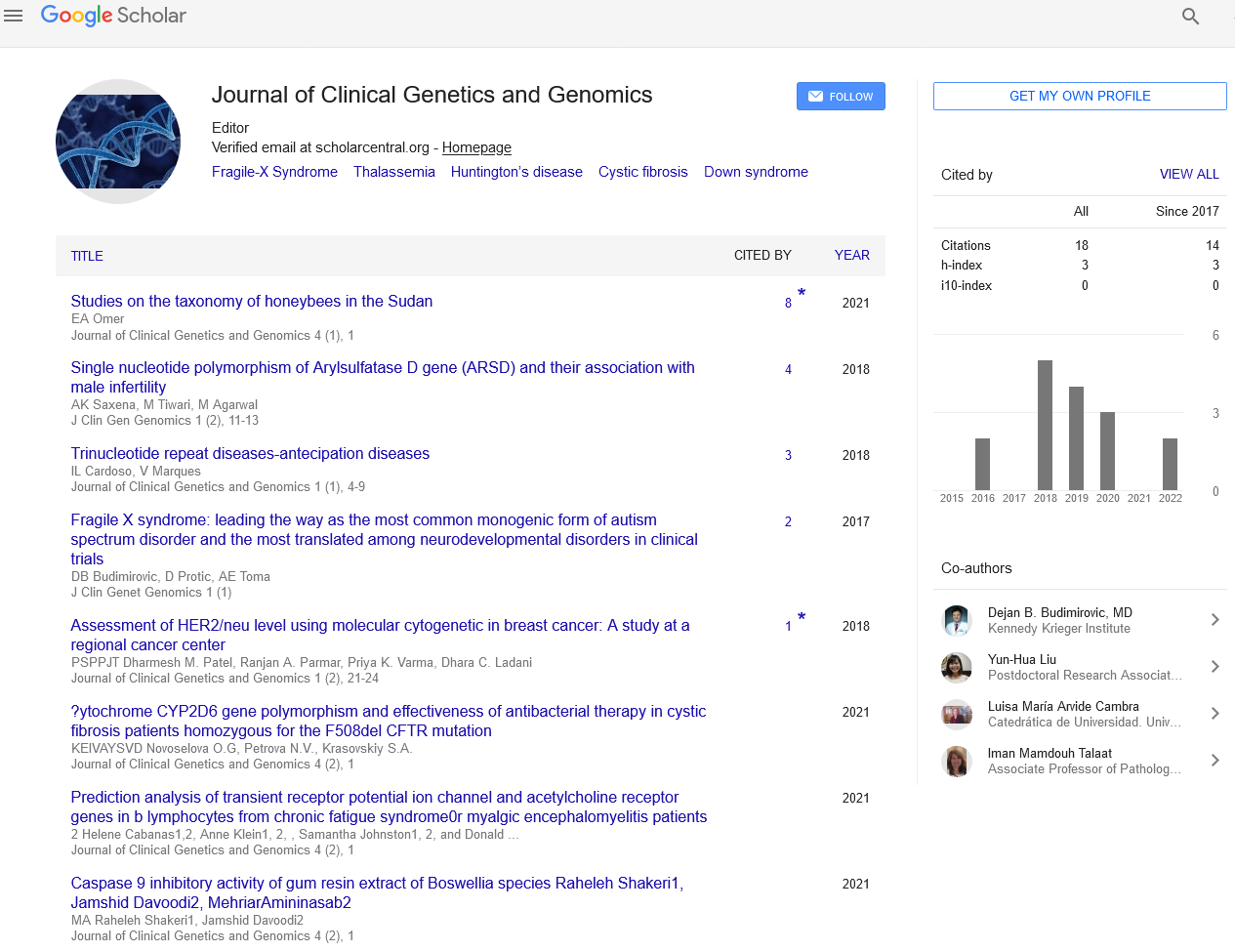Building global health security through international genomics collaboration
Received: 31-Jan-2023, Manuscript No. PULJCGG-23-6123; Editor assigned: 03-Feb-2023, Pre QC No. PULJCGG-23-6123 (PQ); Reviewed: 21-Feb-2023 QC No. PULJCGG-23-6123; Revised: 03-Apr-2023, Manuscript No. PULJCGG-23-6123 (R); Published: 11-May-2023
Citation: Alvarez J. Building global health security through international genomics collaboration. J Clin Genet Genom 2023;6(2):1-2.
This open-access article is distributed under the terms of the Creative Commons Attribution Non-Commercial License (CC BY-NC) (http://creativecommons.org/licenses/by-nc/4.0/), which permits reuse, distribution and reproduction of the article, provided that the original work is properly cited and the reuse is restricted to noncommercial purposes. For commercial reuse, contact reprints@pulsus.com
Abstract
Globally, life sciences are undergoing a profound transformation due to genome science and technology, which is making this field extremely appealing for international collaboration to improve global health. The Los Alamos national laboratory's genome science program is using its extensive experience in genomics research to help a number of partner countries improve their genomics and bioinformatics capabilities. The goal of capability development is to provide a scientific method based on molecular genomics for applications such as pathogen characterization and biosurveillance. Basic genomics principles are introduced, laboratory procedures are taught and bioinformatic analysis of the resulting data is practised. Additionally, next-generation sequencing instruments are purchased and installed. Bioinformatics software capabilities are established. Finally, collaborative applications of genomics capabilities in public health are investigated. In the Republic of Georgia, the Kingdom of Jordan, Uganda, and Gabon, genome centres have been formed with public health and research institutes. Broader genomics application collaborations have also been developed with research institutions in many other nations.
Keywords
Bioinformatics; Genome science; Biosurveillance; Sequencing; Genomics
Introduction
The American Association for the Advancement of Science (AAAS), a renowned general scientific society in the US, recognised the importance of international scientific collaboration in early 2010 and organised a series of four conferences with the common theme of "International Engagement: Responsible bioscience for a safe and secure society." These conferences, with an emphasis on the larger Middle Eastern and North African region, reviewed the crucial concerns and explored possibly viable options for collaboration between scientists in the US and other nations over the course of two years. The key takeaways from these conferences were a clear willingness for collaborative research and development with ethical scientific conduct and forward looking action to improve the surveillance of infectious diseases under the one health concept. Although the AAAS conference series had a regional focus, there is no doubt that the ideas that emerged from the meeting and the methods that can be applied are transferable to many other nations and regions. Addressing complex global concerns, like how to approach the One Health concept, requires effective and long lasting alliances that build on shared interests, complementary skills, and supporting infrastructure.
Successful international cooperation is built on scientists who have the motivation and means to establish and maintain collaborations with peers abroad and who can get past any obstacles in their way.
Description
The global public health communities share the goal of lowering the risk to global health security posed by the spread of harmful infectious illnesses, whether they are caused by human activity or not. Additionally, it has evolved into the main goal of global cooperation in scientific engagement and biothreat reduction initiatives.
The ability of a global network to reduce risk and improve compliance with international regulations, like the international health regulations and those by the world organization for animal health, depends on engaging with and empowering infectious disease detection and surveillance capabilities in the partner countries (OIE). The difficulties of global health security have been addressed through extensive multinational collaborations, with initiatives like bioethics debate, responsive scientific conduct, biorisk management and field epidemiology having a beneficial global influence.
Genomic research for global health security applications offered by next generation sequencing is a suitable scientific strategy that complements the aforementioned actions. Although genomics is a relatively new field of science, it is essential to many strategies for securing health. The field has been rapidly developing thanks to highly automated Next Generation DNA Sequencing (NGS) technologies, both in terms of the breadth of applications in fields like agriculture and medicine (disease mechanisms, diagnostics, and therapeutics) and the depth of understanding of genome structure and function in living organisms. Prior to now, it has been difficult, expensive and time consuming to use high throughput DNA sequencing for pathogen detection during an infectious disease outbreak or for biosurveillance.
In the last ten years, NGS has essentially become more accessible, moving from centralised sequencing laboratories to individual institutions thanks to the development of highly automated instrument platforms, streamlined operational procedures and protocols, readily available reagent kits and data analysis pipelines. As a result, genomics is now a highly sought after field that encourages extensive multinational partnerships aimed at numerous applications. Applications for diagnosing infectious diseases, identifying previously unidentified organisms, characterization of sample archives and biosurveillance are a few examples of those relevant to global health security.
High throughput DNA sequencing is now more affordable thanks to NGS technology, but automated tools and streamlined processes cannot replace in depth knowledge and experience in using them accurately and proficiently, just as analytic algorithms cannot accurately interpret the results of experiments. These technological improvements cannot be fully utilised without specific education and technical know-how.
Conclusion
The genome science program at the Los Alamos National Laboratory (LANL) has been leveraging our own capabilities to support an increasing number of partner countries on four continents in developing molecular genomic based pathogen detection and characterization capabilities. This is done in support of the overarching scientific engagement objectives. To begin such development, we first identify the needs and limitations in the genomics and bioinformatics capabilities of partner countries. The development of facilities, the distribution of pipelines and procedures for microorganism genotypic characterization and scientific and technical training come next.





